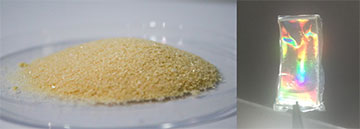![]()
Researchers developed a process to turn crab shells into a bioplastic that can be used to make diffraction gratings (in the tweezers). [Image: R.A. Guerrero, Ateneo de Manila University]
The Philippines produces over 250,000 metric tons of seafood waste every year, with up to 40% in the form of thrown-away shells. In particular, the blue swimming crab—or “alimasag” as it is locally known—is a lucrative commodity for local fisheries that produces a significant amount of waste.
Researchers at Ateneo de Manila University, Philippines, have found that discarded crab shells can have a second life as a diffraction grating (Appl. Opt., doi: 10.1364/AO.483336). The bioplastic gratings, fabricated using soft lithography with chitosan extracted from the shells, are lightweight, inexpensive and biodegradable, according to the researchers.
Making waste useful
According to the United Nations, unsustainable patterns of consumption and production are root causes of the triple planetary crises of climate change, biodiversity loss and pollution. A large proportion of seafood waste occurs during processing. For example, around 70% of blue swimming crab parts have already been disposed of before the product reaches the consumer.
“One of our co-authors, Efren Gumayan, visited a local crab meat processing plant in Northern Iloilo, Philippines, where he observed a large amount of crab shell waste generated each day,” said senior author Raphael A. Guerrero. “He was inspired to convert this waste material into a useful product.”
The researchers ground dried crab shells into a powder (left) and then used a chemical process to create a solution suitable for making a diffraction grating (right). [Image: E.G. Gumayan, Ateneo de Manila University] [Enlarge image]
The researchers oven-dried blue swimming crab shells, ground them up and extracted chitosan, a cationic polymer obtained by deacetylation of chitin, from the resulting powder. For the soft lithography process, they prepared a silicone cast of a commercial grating, with the original microscopic grooves copied onto the silicone surface. The silicone grating replica would act as a mold for fabricating the chitosan gratings.
Lastly, the researchers dissolved the chitosan powder in acid to form a solution, which they poured into the silicone grating mold. Upon hardening, the bioplastic replica was peeled off, with grating structures successfully copied onto the chitosan surface.
Sustainability in optics
Guerrero and his colleagues examined the chitosan gratings using atomic force microscopy, confirming that the periodic nanoscale groove structures—corresponding to densities of 600 and 1200 lines/mm—matched those of the commercial grating. Furthermore, diffraction experiments with an argon ion laser with its wavelength at 514.5 nm produced the expected beam patterns.
Power efficiency of the chitosan replicas was measured to be low, but the values were still comparable to the output of silicone gratings. A next step for the project would be to optimize the chemical process and resulting physical properties of chitosan to maximize the power efficiency.
The researchers foresee lightweight and inexpensive spectrometers based on chitosan gratings being employed as single-use analytical tools for field work. Chitosan could be the base material for the spectrometer packaging, and disposing of the biodegradable devices would have minimal impact on the environment.
“We hope that our paper leads to more researchers considering the use of waste materials for optical applications, resulting in less solid waste requiring disposal and improved sustainability in optical manufacturing,” said Guerrero.

